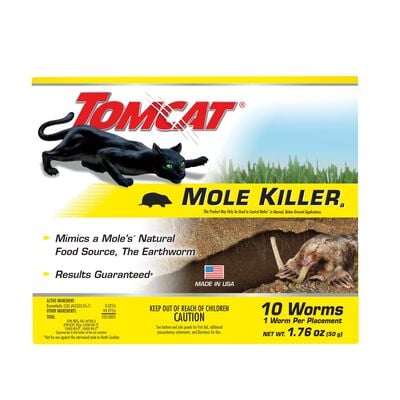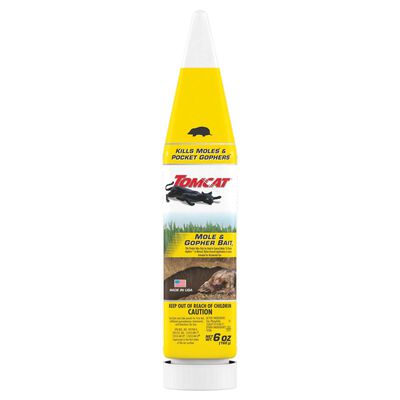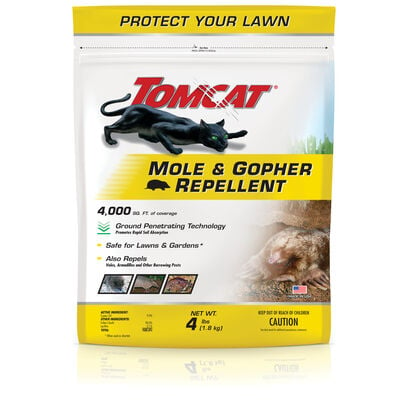
HOW TO USE TOMCAT® MOLE KILLER BAITED WORMS & GRUBS
Learn how Tomcat® Mole Killer baited worms and grubs work and get usage tips for using mole baits.
Moles spend the majority of their lives tunneling underground in search of food, causing unsightly damage to your lawn and garden. Tomcat® Mole Killer offers relief for anyone who's struggled to control moles. Below are essential tips to help you identify and bait active surface runways or deep tunnels where moles live to help you eliminate them in your yard.
Tomcat® Mole Killer is designed to mimic the mole's natural food source—the earthworm and grub—in both shape and feel. It kills in a single feeding, and moles usually die in their tunnels within 12-24 hours of ingesting a single bait placement.
Before placing Tomcat® Mole Killer, deciding on a prime location is essential. Moles create two types of tunnels: surface runways and deep tunnels. Each type of tunnel has its own distinct appearance above ground.
Surface Runways
Surface runways appear as raised, brown, grassless streaks on a lawn, created when moles tunnel below. These unsightly patches fall into two categories: primary and exploratory. Primary

runways indicate active tunnels that you will want to bait. Generally these runways are long, relatively straight tunnels that a mole will travel through as often as 3 times a day, making them prime locations for baiting.
Exploratory runways, on the other hand, have the appearance above ground more like a spider web. Moles create them as they explore new feeding areas. They are usually abandoned and should not be baited.
Deep Tunnels
Large mounds of dirt above ground—a molehill—indicate deep tunnels below. This is typically the case in the Pacific Northwest where moles create these volcano-shaped deep tunnels

Baiting Surface Runways
STEP 1: Locate Active Runways
Determine where the active mole runways are located by carefully poking a hole in the top of the surface runway with your index finger,

a small half-inch dowel, or probe. Be careful not to collapse the tunnel or cover up the hole. Mark the hole with a small stick, marking flag, or other marker. Repeat this procedure in several runway locations throughout your yard. After 48-72 hours, revisit the holes to see if they've been sealed. If the mole is traveling through the tunnel, it will typically seal the hole.
If the holes are sealed, you've located an active runway, which can be baited. Leave the marker near the hole. If holes are still open, pull the markers; this is an inactive area.
STEP 2: Bait Active Runways
Only bait the active runways, but do not bait your original assessment holes. (You will use them again later.)

Poke a hole 3 to 5 feet on either side of the assessment hole and place one worm or two grubs down each hole. With a pencil or probe, push the bait as far down as you can. Make sure each grub or worm is sitting on the floor of the runway. If it is not, the mole may fail to see the bait or push it out of the tunnel.
After pushing the worm or grub down to the floor of the runway, reseal the runway with dirt to keep out any light. Pinch the hole closed or cover it with a piece of sod or a small rock. Be careful not to collapse or disturb the runway.
IMPORTANT: Once you have baited the tunnel on either side of the assessment hole, re-open the assessment hole.
Bait other active runways in a similar manner. After 48-72 hours, check to see if the assessment hole is resealed. If it's plugged, you know the mole has traveled through the runway and more than likely eaten the bait.
STEP 3: Check for Mole Activity
One week later, verify that you mole problem has been eliminated by repeating the pre-baiting assessment process (poking holes in surface tunnels). If continued activity is found, re-bait these locations.
Baiting Deep Tunnels
STEP 1: Locate Active Deep Tunnels
Unlike surface tunnels where you place bait on either side of an active assessment tunnel, you bait deep tunnels directly. To locate a deep tunnel,

scrape the dirt away from the mound and locate the tunnel opening or hole, which leads down to the mole's active tunnel.
Once you've located the opening, insert a long probe (a broom handle or stick, for example) into the hole and carefully move it about until you've determined the direction (slant) of the passageway leading to the deep tunnel. When the probe enters the tunnel, you will feel a quick decrease in resistance from the probe.
Repeat this procedure at other locations. Then wait 48-72 hours to see if the holes are resealed; bait where holes have been resealed.
STEP 2: Bait Active Deep Tunnels
Re-open the sealed assessment hole again by inserting a long probe into the hole opening and carefully moving it until you've found the

passageway leading to the deep tunnel. (Again, when the probe enters the tunnel, you will feel a quick decrease in resistance from the probe.)
To bait the tunnel, drop one worm or two grubs deep into the tunnel. Use the probe to push the bait completely into the tunnel. Cover the hole with dirt, a rock, or other object.
STEP 3: Check for Mole Activity
One week later, verify your mole problem has been eliminated by repeating the pre-baiting assessment process. If continued activity is found, re-bait the tunnels.
TIP: If you have both surface runways and deep tunnels in the same area, we recommend you follow the baiting strategy for surface tunnels.


